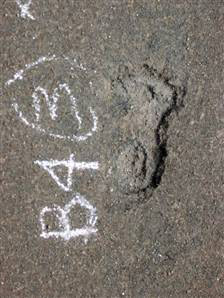 |
 |
 |
 News Around the Republic of Mexico | December 2005 News Around the Republic of Mexico | December 2005  
UPDATE: New Doubts Raised About Old 'Footprints'
 Reuters Reuters


| | The apparent imprint of toes and a heel can be seen in hardened volcanic ash just below the bare foot in this image, taken at an abandoned Mexican quarry. (Liverpool John Moores University/Bournemouth University) |
Scientists cast doubt on Wednesday on the nature of impressions discovered in Mexico that had been interpreted to represent footprints and suggested that humans had arrived in the Americas far earlier than previously thought.

In 2003, an international team of scientists headed by Silvia Gonzalez of John Moores University in Liverpool, England found what they said were about 250 human and animal prints in a layer of volcanic ash near Puebla, Mexico.

They estimated that early hunters walked across the ash deposited near a lake 40,000 years ago. Prior to that discovery, humans were thought to have arrived in the Americas across a land bridge from Asia about 11,000 years ago.

However, a different group of researchers from the United States and Mexico came to a different conclusion after visiting the site and collecting samples.

"You're really only left with two possibilities," one of the skeptics, Paul Renne of the University of California at Berkeley, said in a statement. "One is that they are really old hominids — shockingly old — or they're not footprints."

Renne and a team of geologists and anthropologists who used an argon dating technique and another method to analyze the age of fossils said they were about 1.3 million years old.

"We conclude that either hominid migration into the Americas occurred very much earlier than previously believed, or that the features in question were not made by humans on recently erupted ash," Renne and his team said in a report in the journal Nature.
Mexican Footprints Cause Scientific Stir
Associated Press


| | This imprint has the shape of a human foot. (Liverpool John Moores University/Bournemouth University) |
British scientists claimed on Tuesday to have unearthed 40,000-year-old human footprints in central Mexico, challenging previous studies that put the arrival of the first humans in the Americas at about 13,500 years ago.

Scientists Silvia Gonzalez, from Liverpool John Moores University, and Matthew Bennett, of Bournemouth University, found the footprints in an abandoned quarry close to the Cerro Toluquilla volcano in the Valsequillo Basin, near Puebla, south of Mexico City in 2003.

Gonzalez said the footprints were preserved as trace fossils in volcanic ash along what was the shoreline of an ancient volcanic lake.

"Climate variations and the eruption of the Cerro Toluquilla volcano caused lake levels to rise and fall, exposing the Xalnene volcanic ash layer," Gonzalez said.

She said the footprints, which were preserved when water levels rose, were now as hard as concrete and had been uncovered without excavation after quarry workers removed 6 to 10 feet (2 to 3 meters) of lake sediment that had been deposited on top of the volcanic ash layer.

The footprints were analyzed and dated by a team of international scientists using laser technology.

The findings challenge previously held ideas about the settlement of the Americas.

Scientists have long believed that the first humans came to North America after the last Ice Age ended about 13,500 years ago. According to that theory, they crossed a land bridge from Asia into what is now Alaska and spread quickly across the continent.

The theory is supported by the stone tools they left behind — all less than 13,500 years old. Their tool technology was named "Clovis" for the New Mexico town where it was first described.

"The existence of 40,000 year-old human footprints in Mexico means that the 'Clovis First' model of human occupation can no longer be accepted as the first evidence of human presence in the Americas," said David Huddart, a professor at Liverpool John Moores University and a collaborator on the discovery.

Gonzalez said the findings supported a theory that the first colonies may have arrived by water, using the Pacific coast migration route, rather than by foot.

"We think there were several migration waves into the Americas at different times by different human groups," she said.

The findings are being exhibited as part of a summer exhibition at London's prestigious scientific academy, the Royal Society. | 
 | |
 |



